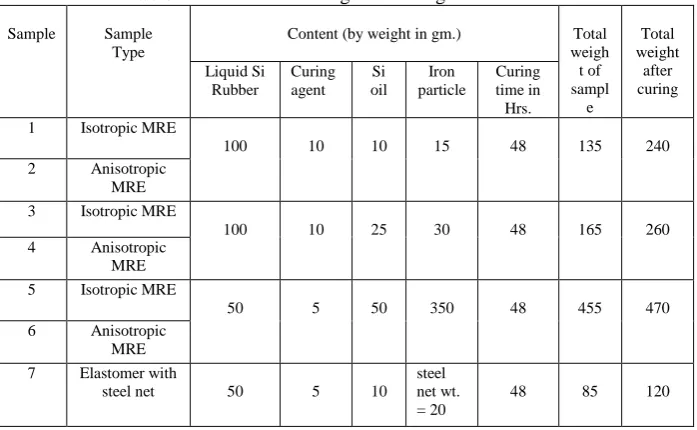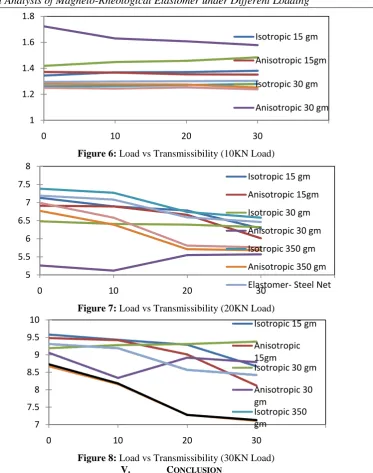ISSN (Online): 2320-9364, ISSN (Print): 2320-9356
www.ijres.org Volume 4 Issue 10 ǁ October. 2016 ǁ PP.73-78
Vibrational Analysis of Magneto-Rheological Elastomer under
Different Loading
Akhil M. Chaudhari
1, Dr. K. B. Waghulde
2 1(Mechanical Engineering Department, Scoe Vadgaon, Pune, Maharashtra, India)2(Mechanical Engineering Department, Pvpit, Bavdhan, Pune)
Abstract :
This report presents the experimental and analytical modal analysis of a magneto-rheological elastomer. The effective material and geometrical properties are measured, and the dynamic behaviour is investigated through testing. Fabrication of isotropic and anisotropic magneto-rheological elastomers with different percentages of iron particles are carried out. Also two numbers of silicon elastomer in which one having steel net kept layer by layer in place of iron particles during pouring of liquid silicon elastomer in mould, other is simple silicon elastomer without iron particle or steel net are fabricated.The modal analysis of all samples are being analyzed using FFT analyser. And transmissibility and amplitudes of all samples are compared with respect to load. A comparative study has been made between different samples of MRE‟s using results and comparisons obtained using experimental method.Keywords:
Smart material, Magneto-rheological elastomer, Transmissibility, FEM, FFT AnalyserI.
INTRODUCTION
Recently, a very attractive and effective semi-active absorbers featuring magneto-rheological (MR) materials such as MR fluids (MRFs) or MR elastomers (MRE‟s) have been proposed by many investigators. These absorbing devices based on MR technique have a number of attractive characteristics for use in vibration control, such as fast response characteristic to magnetic field, wide control bandwidth and compact size. MR materials include MRFs, MR foams and MREs, whose rheological properties can be controlled by the application of an external magnetic field. The most common MR material is MRFs, which is magnetically polarizable particles suspended in viscous fluids. Since their invention in 1948, MRF technique has made significant advancements. The MRFs have been proved to be commercially viable and well suited for many applications, such as the automotive suspension vibration control, the earthquake resistance, clutch.
Solid analogs of MRFs and MREs can avoid those disadvantages such as settling of particles normally associated with MRFs. MREs include a wide variety of composite materials, which typically consist of magnetically polarizable particles dispersed in a polymer medium. The mechanical properties of MREs such as the storage and loss modulus are altered reversibly by the application of an external magnetic field. Moreover, MREs do not need channels or seals to hold or prevent leakage, are more stable and avoid the particle sedimentation associated with MRFs. Therefore, MREs have many potential engineering applications for vibration control in damping and vibration isolation systems.
Figure 1 : Structure of Magnetorheological elastomer, Ferromagnetic particles in a elastomer (a) under no magnetic field, and (b) with magnetic field applied.
II.
FABRICATION
OF
MAGNETO-RHEOLOGICAL
ELASTOMERS
For preparation of MRE, different types of rubbers were available in market. While selecting a particular type of rubber, its properties and availability were considered. In this work RTV Sylgard‟s184 silicone elastomer (made from Dow corning Ltd. Powai, Mumbai) was selected due to its inherent advantages like it cures at constant rate, regardless of sectional thickness degree of confinement, works in wide temperature range that is from -45ºC to 200ºC, post curing is not require at any condition, available easily, shrinkage is minimum at the timing of curing, no exothermal reaction taking place during curing, clean curing process without formation of any byproducts, and having a good dielectic properties. The Sylgard‟s184 was available in two parts namely part A, and part B. Part A is base while part B is curing agent. It was recommended to mix A and B in proportion of 10:1.
Table 1. Fabrication of magnetorheological elastomers
Sample Sample Type
Content (by weight in gm.) Total weigh t of sampl
e
Total weight
after curing Liquid Si
Rubber
Curing agent
Si oil
Iron particle
Curing time in Hrs. 1 Isotropic MRE
100 10 10 15 48 135 240
2 Anisotropic MRE 3 Isotropic MRE
100 10 25 30 48 165 260
4 Anisotropic MRE 5 Isotropic MRE
50 5 50 350 48 455 470
6 Anisotropic MRE 7 Elastomer with
steel net 50 5 10
steel net wt. = 20
48 85 120
Figure 2 : Sample of Isotropic MRE (Sample no.1,3,and 5)
Figure 3 : Sample of Anisotropic MRE (Sample no.2,4,and 6)
Figure 4 : Sample of Elastomer with steel net (Sample no.7)
III.
EXPERIMENTAL
SYSTEM
DEVELOPMENT
This section discusses the process of manufacturing as well as the components of the experimental systems; the type of signal employed, and test results.
Figure 5 : Experimental set up
by upper accelerometer fixed at the top of the set-up and lower accelerometer placed near or on the vibration exciter as shown in Fig. 5. The test was performed with all the samples of isotropic and anisotropic MRE with zero load, 10N, 20N and 30N load respectively.
IV.
RESULT
AND
DISCUSSION
There is a fraction changes in transmissibility in all samples as per the load increases but generally in isotropic MRE as the load increases transmissibility increases and in anisotropic MRE there is decrease in transmissibility as the load increases. Maximum variation in transmissibility occurs in isotropic and anisotropic MRE with 30 gm iron particles because it shows maximum vibration absorption among all samples. It is shown in Fig. 6.
There is reduction in upper amplitudes in all samples as per the load increases. In isotropic MRE with 30 gm iron particles there is less reduction in upper amplitude and anisotropic MRE with 30 gm iron particles shows opposite changes among all MRE samples. It is shown in Fig. 7.
There is reduction in lower amplitudes in all samples as per the load increases. In isotropic MRE with 30 gm iron particles there is increase in lower amplitude and anisotropic MRE with 30 gm iron particles shows reduction in amplitude at 10N after it shows increase in amplitude and again it slightly decreases. It is shown in Fig. 8.
Table 2 : % of Vibration Absorption for Different Load
Samples Frequency Load Amplitude Transmissibility % of vibration absoption
1 48.3
Zero Upper
7.13 1.3436 25.574
Lower 9.58
10N Upper 6.89
1.3687 26.935
Lower 9.43
20N Upper 6.78
1.3702 27.018
Lower 9.29
2 48.3
Zero Upper
6.91 1.3719 27.110
Lower 9.48
10N Upper 6.89
1.3672 26.858
Lower 9.42
20N Upper 6.66
1.3529 26.082
Lower 9.01
3 48.3
Zero Upper
6.48 1.4182 29.489
Lower 9.19
10N Upper 6.41
1.4477 30.927
Lower 9.28
20N Upper 6.39
1.4570 31.364
Lower 9.31
4 48.3
Zero Upper
5.26 1.7224 41.943
Lower 9.06
10N Upper 5.12
1.6289 38.609
Lower 8.34
20N Upper 5.55
1.6072 37.780
Lower 8.92
5 48.3
Zero Upper
7.38 1.2615 20.730
Lower 9.31
10N Upper 7.27
1.2641 20.892
Lower 9.19
20N Upper 6.74
1.2715 21.354
Lower 8.57
6 48.3
Zero Upper
6.77 1.2806 21.915
Lower 8.67
10N Upper 6.39
1.2770 21.691
Lower 8.16
20N Upper 5.71
1.2750 21.566
Lower 7.28
7 48.3
Zero Upper
7.19 1.2949 22.771
Lower 9.31
10N Upper 7.08
1.2980 22.960
Lower 9.19
20N Upper 6.59
1.3005 23.104
Figure 6: Load vs Transmissibility (10KN Load)
Figure 7: Load vs Transmissibility (20KN Load)
Figure 8: Load vs Transmissibility (30KN Load)
V. CONCLUSION
As when the MR elastomer was tested without magnetic field under zero load, 10N load, 20N load and 30N load respectively reduced the amplitude of vibration at same frequency also transmissibility and percentage of vibration absorption increases with increases the load. And as when the MR damper was tested with magnetic
field under zero load, 10N load, 20N load and 30N load respectively transmissibility and percentage of vibration absorption decreases with increases the load. The best results of percentage of vibration control is obtained with fabrication of anisotropic and isotropic MRE with 30 gm iron particle behind that anisotropic and isotropic MRE with 15 gm iron particle have good results of vibration control. It observed that when we increases the percentages of iron particle in same MRE sample from normal limit transmissibility and percentage of vibration absorption decreases. If we put thin steel net in place of iron particle layer by layer in between layer of elastomer shows moderate results of vibration control.
REFERENCES
[1]. DONG Xiao-min, YU Miao, LIAO Chang-rong, CHEN Wei-min,(2009) “A new variable stiffness absorber based on magneto-rheological elastomer” International Journal of Nonferrous Met. Soc. China 19(2009) s611−s615
[2]. G. J. Liao, X-L Gong, S. H. Xuan, C. J. Kang and L. H. Zong,(2011) “Development of a real-time tunable stiffness and damping vibration isolator based on magnetorheological elastomer” Journal of Intelligent Material Systems and Structures 23(1) 25–33
1 1.2 1.4 1.6 1.8
0 10 20 30
Isotropic 15 gm
Anisotropic 15gm
Isotropic 30 gm
Anisotropic 30 gm
5 5.5 6 6.5 7 7.5 8
0 10 20 30
Isotropic 15 gm
Anisotropic 15gm
Isotropic 30 gm
Anisotropic 30 gm
Isotropic 350 gm
Anisotropic 350 gm
Elastomer- Steel Net
7 7.5 8 8.5 9 9.5 10
0 10 20 30
Isotropic 15 gm
Anisotropic 15gm
Isotropic 30 gm
Anisotropic 30 gm
[3]. Yancheng Li, Jianchun Li, Weihua Li,(2013), “Design and experimental testing of an adaptive magneto- rheological elastomer base isolator” IEEE / ASME International Conference on Advanced Intelligent Mechatronics (AIM) (pp. 381-386). United States: IEEE.
[4]. Xianzhou Zhang, SuiliPeng,WeijiaWen,Weihua Li,(2008), “Analysis and fabrication of patterned magnetorheological elastomers” IOP Published Smart Mater. Struct.17 045001 (5pp)
[5]. S.R.Kumbhar, SubhasisMaji, Bimlesh Kumar,(2013),“Development and Characterization of Isotropic Magnetorheological Elastomer” Universal Journal of Mechanical Engineering 1(1): 18-21, 2013 [6]. SriharshaHegde, K.V. Gangadharan, (2014), “Testing of RTV-Silicone based thick
magnetorheological elastomers under harmonic loading conditions” International Journal of Scientific & Engineering Research, Volume 5, Issue 2, ISSN 2229-5518



